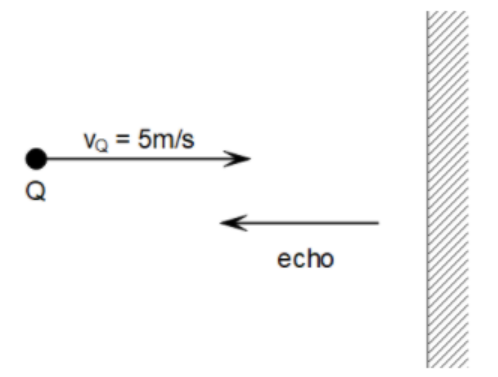
A tuning fork P of unknown frequency gives 7 beats in 2 seconds with another tuning fork Q. When Q runs towards a wall with a speed of 5m/s it gives 5 beats per second with its echo. On loading P with wax, it gives 5 beats per second with Q. What is the frequency of P (in Hz)? Assume speed of sound = 332 m/s.
Answer
496.5k+ views
Hint: First we need to obtain the relation between initial frequencies and beat frequency. The relative movement of Q and the echo gives rise to the doppler effect. By applying the appropriate condition for the doppler effect, we get the frequency of Q. Now, after understanding the loading of P and its significance, we can have the value of P.
Formula used:
Complete answer:
The beat frequency (
Where
Let the unknown frequency of P and Q be
It is mentioned in the question that, when Q runs towards a wall with a speed of 5m/s it gives 5 beats per second with its echo, as shown in the figure

This leads to a Doppler effect. The general formula for the Doppler effect is given by
Here,
In the first case, the source (Q) is said to be moving with velocity
Where
Similarly, in the next case the echo itself acts as a stationary source and the Q acts as a moving object. But here the emitted frequency will be the observed frequency of the previous condition. So, the emitted frequency due to the echo
It is mentioned in the question that, as Q runs towards the wall with a speed of 5m/s it gives 5 beats per second with its echo. Using this condition and the equations obtained above, we have
It is given that loading is done on P, this indicates the decrease in the frequency of P. Now, if you observe, the beat frequency has increased from 3.5Hz to 5Hz, we can say that this is due to a decrease in the frequency of P. This essentially concludes that
So, the initial beat frequency
Therefore, the frequency of P is 323.5Hz.
Note:
One must remember that loading of any tuning fork decreases its frequency. Contrary to this, the filing of a tuning fork increases its frequency. It is because of the change in the inertia of the tuning fork which is a property of mass. As the tuning fork is loaded with wax, inertia increases resulting in decrease of frequency. Incase of filing, the inertia decreases, so the frequency increases.
The echo will have the same speed as a sound.
The beats frequency has the same units as frequency.
Formula used:
Complete answer:
The beat frequency (
Where
Let the unknown frequency of P and Q be
It is mentioned in the question that, when Q runs towards a wall with a speed of 5m/s it gives 5 beats per second with its echo, as shown in the figure

This leads to a Doppler effect. The general formula for the Doppler effect is given by
Here,
In the first case, the source (Q) is said to be moving with velocity
Where
Similarly, in the next case the echo itself acts as a stationary source and the Q acts as a moving object. But here the emitted frequency will be the observed frequency of the previous condition. So, the emitted frequency due to the echo
It is mentioned in the question that, as Q runs towards the wall with a speed of 5m/s it gives 5 beats per second with its echo. Using this condition and the equations obtained above, we have
It is given that loading is done on P, this indicates the decrease in the frequency of P. Now, if you observe, the beat frequency has increased from 3.5Hz to 5Hz, we can say that this is due to a decrease in the frequency of P. This essentially concludes that
So, the initial beat frequency
Therefore, the frequency of P is 323.5Hz.
Note:
One must remember that loading of any tuning fork decreases its frequency. Contrary to this, the filing of a tuning fork increases its frequency. It is because of the change in the inertia of the tuning fork which is a property of mass. As the tuning fork is loaded with wax, inertia increases resulting in decrease of frequency. Incase of filing, the inertia decreases, so the frequency increases.
The echo will have the same speed as a sound.
The beats frequency has the same units as frequency.
Latest Vedantu courses for you
Grade 6 | CBSE | SCHOOL | English
Vedantu 6 Pro Course (2025-26)
School Full course for CBSE students
₹45,300 per year
Recently Updated Pages
Master Class 4 Maths: Engaging Questions & Answers for Success

Master Class 4 English: Engaging Questions & Answers for Success

Master Class 4 Science: Engaging Questions & Answers for Success

Class 4 Question and Answer - Your Ultimate Solutions Guide

Master Class 11 Economics: Engaging Questions & Answers for Success

Master Class 11 Business Studies: Engaging Questions & Answers for Success

Trending doubts
Give 10 examples of unisexual and bisexual flowers

Draw a labelled sketch of the human eye class 12 physics CBSE

Differentiate between homogeneous and heterogeneous class 12 chemistry CBSE

a Tabulate the differences in the characteristics of class 12 chemistry CBSE

Why is the cell called the structural and functional class 12 biology CBSE

Differentiate between insitu conservation and exsitu class 12 biology CBSE




